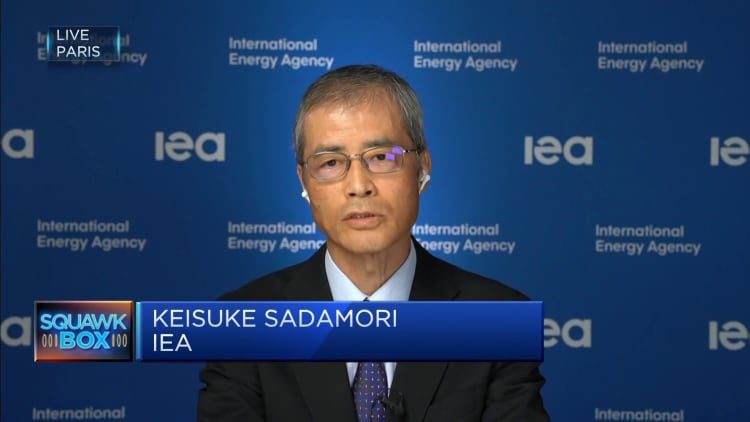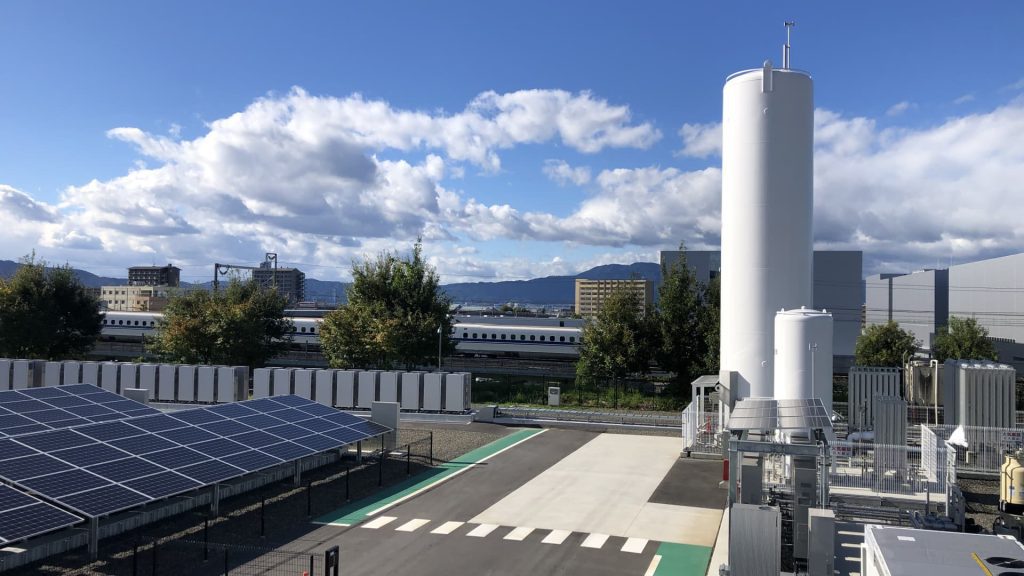As an express train speeds by in the background, a liquid hydrogen tank towers above solar panels and hydrogen fuel cells at Panasonic’s Kusatsu plant in Japan. Combined with the Tesla Megapack’s storage battery, hydrogen and solar energy could provide enough electricity to power the Ene-Farm fuel cell plant on site.
Tim Hornyak
As bullet trains travel at 285 kilometers per hour, Panasonic’s Norihiko Kawamura looks up at a hydrogen storage tank in Japan. The 14-meter-tall structure looms over the tracks of the Tokaido Shinkansen line outside the ancient capital of Kyoto, as well as a slew of solar panels, hydrogen fuel cells and Tesla Megapack storage batteries. Energy sources can generate enough juice to power a portion of a manufacturing site using only renewable energy.
“This may be the largest hydrogen consumption site in Japan,” says Kawamura, a manager in the device maker’s smart energy system business division. “We estimate the use of 120 tons of hydrogen per year. As Japan produces and imports more and more hydrogen in the future, this will be a very suitable type of plant.”
Panasonic’s plant in Kusatsu, Shiga Prefecture, is located between a high-speed rail line and a highway, and is a sprawling 52-hectare site. It was originally built in 1969 to manufacture goods including refrigerators, and is one of the “Three Treasures” of home appliances, along with televisions and washing machines, that the Japanese wanted to rebuild after the devastation of World War II.
Today, one corner of the plant is the H2 Kibou field, an experimental sustainable energy facility that began operations in April. It consists of a 78,000 liter hydrogen fuel tank, a 495 kW hydrogen fuel cell array of 99 5 kW fuel cells, 570 kW of 1,820 photovoltaic solar panels arranged in an inverted “V” shape to capture the most sunlight, and 1.1 megawatts of lithium-ion battery storage.
On one side of the H2 Kibou Field, a large screen indicates the amount of power being produced in real time from the fuel cells and solar panels: 259kW. About 80% of the energy generated comes from fuel cells, with solar power accounting for the remainder. Panasonic says the facility produces enough power to meet the needs of the on-site fuel cell plant — with a maximum capacity of about 680 kilowatts and an annual use of about 2.7 gigawatts. Panasonic believes it can serve as a model for the next generation of new sustainable manufacturing.
“This is the first site of its kind that uses 100% renewable energy,” says Hiroshi Kinoshita of Panasonic’s Intelligent Energy Systems Business Division. “We want to expand this solution towards creating a decarbonized society.”
The 495 kW hydrogen fuel cell assembly consists of 99 5 kW fuel cells. Panasonic says it is the first site of its kind in the world to use hydrogen fuel cells in a plant that runs on 100% renewable energy.
Tim Hornyak
An AI-equipped Energy Management System (EMS) automatically controls on-site power generation, switching between solar and hydrogen, to reduce the amount of electricity purchased from the local grid operator. For example, if it is a sunny summer day and a fuel cell plant needs 600 kW, the EMS might prioritize solar panels, and decide on a mix of 300 kW solar cells, 200 kW hydrogen fuel cells, and 100 kW storage batteries. Watt. However, on a cloudy day, it may reduce solar components, boosting hydrogen and storage batteries, which are recharged at night by fuel cells.
“The most important thing to make manufacturing greener is an integrated energy system including renewable energy such as solar, wind, hydrogen, batteries, etc.,” says Takamchi Oishi, senior manager of climate change and energy at Deloitte Tohmatsu Consulting. “To do this, Panasonic’s example is close to an ideal power system.”
With gray hydrogen, it’s not completely green yet
The H2 Kibou field is not entirely green. It is based on so-called gray hydrogen, which is produced from natural gas in a process that can release a lot of carbon dioxide. Tankers transport 20,000 liters of hydrogen, cooled in liquid form to minus 250 degrees Celsius, from Osaka to Kusatsu, a distance of about 80 kilometers, about once a week. Japan has relied on countries like Australia, which have larger supplies of renewable energy, to produce hydrogen. But the local supplier Iwatani Corporation partnered with chevron Earlier this year to build 30 hydrogen refueling sites in California by 2026, he opened a technology center near Osaka focused on Green hydrogen productionwhich was created without the use of fossil fuels.
Another issue slowing adoption is cost. Although electricity is relatively expensive in Japan, it currently costs much more to run a hydrogen plant than to use power from the grid, but the company expects that Japanese government and industry efforts to improve supply and distribution will make the component much cheaper.
“Hopefully, the cost of hydrogen will go down, so we can get around 20 yen per cubic meter of hydrogen, and then we’ll be able to achieve cost parity with the electric grid,” Kawamura said.
Panasonic also expects that Japan’s push to become carbon neutral by 2050 will boost demand for new energy products. The Kusatsu fuel cell plant has produced more than 200,000 Ene-Farm natural gas fuel cells for home use. Commercialized in 2009, the cells extract hydrogen from natural gas, generate power by reacting it with oxygen and heat and store hot water, and deliver up to 500 watts of emergency power for eight days in the event of disaster. Last year, it started selling a pure hydrogen version aimed at commercial users. It wants to sell fuel cells in the US and Europe because the governments there have it The most aggressive hydrogen cost reduction measures from Japan. In 2021, the US Department of Energy launched the so-called Hydrogen Shot program that aims to cut the cost of clean hydrogen by 80% to $1 per kilogram over 10 years.
Panasonic does not plan to increase the size of the H2 Kibou field at this time, as it would like to see other companies and factories adopt similar power systems.
It wouldn’t necessarily make economic sense today, Kawamura says, “but we want to start something like this so it’s ready when the cost of hydrogen comes down. Our message is: if we want to have 100% renewable energy in 2030, then we should start with something like this.” Now, not in 2030.”


“Amateur organizer. Wannabe beer evangelist. General web fan. Certified internet ninja. Avid reader.”




/cdn.vox-cdn.com/uploads/chorus_asset/file/25550621/voultar_snes2.jpg)


More Stories
Bitcoin Fees Near Yearly Low as Bitcoin Price Hits $70K
Court ruling worries developers eyeing older Florida condos: NPR
Why Ethereum and BNB Are Ready to Recover as Bullish Rallies Surge